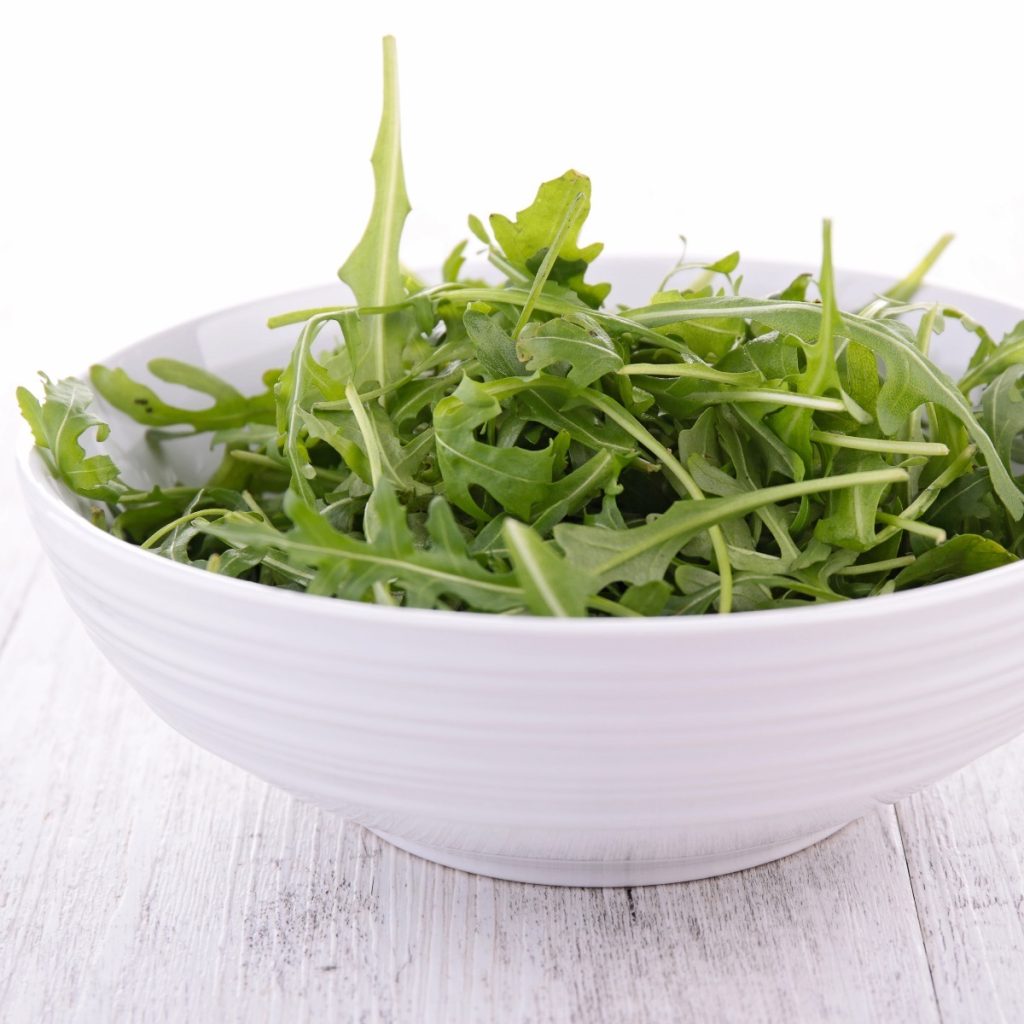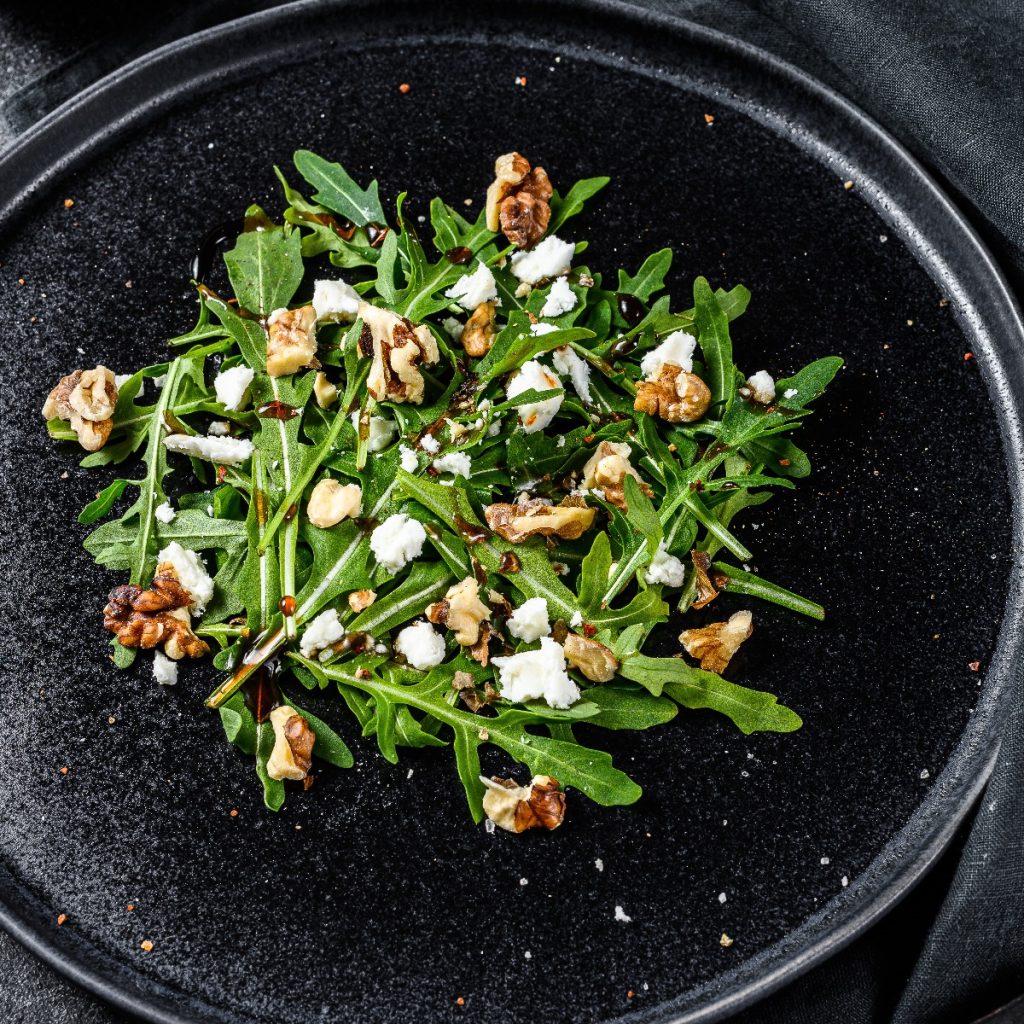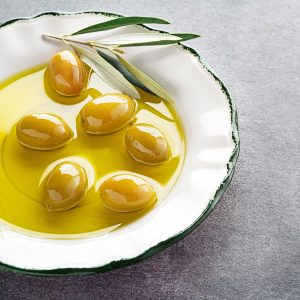Everything You Need to Know About Arugula
Arugula brings a peppery, slightly bitter kick that can wake up almost any dish. This leafy green—also called rocket or rucola—packs way more flavor than its delicate appearance suggests.
Toss it into salads for a fresh bite, layer it onto pizza after baking for a zesty finish, or mix it into pasta for a bright contrast. It pairs well with lemon, Parmesan, balsamic vinegar, and even sweet fruits like pears or strawberries.
Arugula isn’t just tasty—it’s also good for you. It’s full of vitamins A, C, and K, plus it delivers antioxidants and minerals like calcium and potassium.
Whether you grab a bunch from the farmers’ market or a bag from the store, arugula is easy to work with. The younger, smaller leaves tend to be milder, while mature leaves bring more of that bold, peppery punch.
One quick tip: If the flavor feels too strong, you can tone it down by tossing the leaves with a squeeze of lemon or a drizzle of olive oil. Arugula also wilts quickly, so add it at the end of cooking or serve it raw to keep that fresh crunch. Once you start using arugula, you’ll find endless ways to enjoy it!
My mom never served it to us as kids growing up in New Jersey. My dad would have called it a weed. I can’t imagine my brother, sister, or I enjoying it as our side salad. We grew up on iceberg lettuce.
Types of Arugula
There are several different types of arugula, each with a unique flavor and appearance. Some of the most popular types of arugula include:
Type of Arugula | Appearance | Taste | Best Used For |
| Astro Arugula | Broad, flat leaves, light green | Mild, less peppery, slightly sweet | Salads, egg dishes, wraps |
| Baby Arugula | Small, tender, bright green leaves | Mild, slightly peppery | Fresh salads, side greens |
| Common Arugula (Eruca vesicaria) | Medium-large rounded leaves | Mildly peppery, slightly nutty | Salads, sandwiches, pesto |
| Dragon’s Tongue | Green leaves with purple veins | Peppery with a sweet undertone | Visual appeal in salads, sandwiches, garnishes |
| Italian Arugula | Large, broad dark green leaves | Bold peppery taste | Pasta, grilled meats, hearty salads |
| Red Veined Arugula | Bright green leaves with striking red veins | Milder peppery with earthy notes | Colorful salads, cheese plates, visual dishes |
| Rustic Arugula | Medium, slightly jagged leaves | Balanced peppery flavor | Grain bowls, sandwiches, egg dishes |
| Slow Bolt Arugula | Medium-large leaves, resists bolting | Mild to moderately peppery | Extended harvest, salads, sautés |
| Sylvetta Arugula | Fine, delicate leaves | Very peppery, nutty | Microgreens, garnishes, high-end plating |
| Wasabi Arugula | Crisp, smooth leaves | Strong spicy bite, wasabi-like heat | Sushi, spicy salads, bold garnishes |
| Wild Arugula (Diplotaxis tenuifolia) | Small, deeply lobed, thin leaves | Very peppery, intense, slightly bitter | Pizza, pasta, mixed with milder greens |
These are just a few examples of the many types of arugula available. Each type has its unique flavor and appearance, making it a versatile and exciting ingredient to experiment with in the kitchen.
How to Enjoy Arugula
Use | Description | Fresh or Cooked |
| Salads | Tossed raw into mixed green salads or stand-alone with simple vinaigrette | Fresh |
| Pizza Topping | Scattered on hot pizza after baking for a peppery, fresh contrast | Fresh (on hot pizza) |
| Pasta | Folded into hot pasta just before serving for a slightly wilted, aromatic bite | Cooked (lightly) |
| Pesto | Blended with nuts, cheese, olive oil for a zesty alternative to basil pesto | Fresh (processed) |
| Sandwiches & Wraps | Layered inside sandwiches, burgers, or wraps for a crisp, spicy note | Fresh |
| Egg Dishes | Added to omelets, frittatas, or scrambled eggs for bright flavor | Cooked (lightly) |
| Soups | Stirred into soups at the end for added color and flavor | Cooked (lightly) |
| Grain Bowls | Tossed into bowls with grains like quinoa or farro and roasted vegetables | Fresh or cooked |
| Sautéed or Wilted | Quickly sautéed with garlic and olive oil for a simple side | Cooked |
| Garnish | Used as a fresh garnish for meats, seafood, and roasted vegetables | Fresh |
| Smoothies & Juices | Blended into green smoothies or juices for a peppery kick | Fresh |
| Microgreens | Grown as baby greens for topping or garnish | Fresh |
| Stuffing for Meat or Fish | Incorporated into stuffing mixtures for rolled meats or baked fish | Cooked |
| Flatbreads & Tarts | Added to savory tarts or flatbreads after baking | Fresh |
When Did Arugula Get So Popular?
Arugula started gaining real popularity in the U.S. in the 1990s. Before that, it was primarily known in Italian-American kitchens and among chefs who loved traditional Mediterranean flavors.
The turning point came with the rise of the gourmet salad movement and farm-to-table dining, when chefs and home cooks began looking for more interesting, flavorful greens beyond iceberg or romaine.
As farmers’ markets and specialty grocery stores expanded, so did access to arugula. It became a star ingredient in mesclun mixes and soon popped up on pizza, pasta, and fancy sandwich menus.
By the early 2000s, its popularity had taken off, helped by the growing awareness of the Mediterranean diet and demand for fresh, nutrient-packed greens. Today, arugula is practically a staple, whether you’re shopping at Whole Foods or your local supermarket.
Five Fun Facts About Arugula
- Arugula was once considered an aphrodisiac: Arugula was believed to have aphrodisiac properties by the ancient Romans and Egyptians. Its Latin name, “Eruca sativa,” is derived from the Latin word for “caterpillar” because it resembles the insect, also believed to be an aphrodisiac.
- It is also known as “rocket”: Arugula has several names, including rocket, roquette, and rucola. The name “rocket” is believed to have originated from the Italian word “cola,” which is the name for arugula in Italy.
- It is a cool-weather crop: it prefers cooler temperatures and grows best in the spring and fall. It can be grown in the summer but may bolt or go to seed in hot weather. In some regions, arugula can be grown year-round if protected from frost.
- It is a common ingredient in Italian cuisine: Arugula is often added to pasta dishes, pizzas, and salads. In Italy, it is commonly served with Parmesan cheese, olive oil, and lemon juice.
- It is easy to grow: it is a fast-growing plant that can be grown in garden beds, containers, or even as a microgreen. It prefers well-draining soil and partial shade or full sun. The seeds can be sown directly into the soil or started indoors and transplanted outside. Arugula can be harvested as soon as four weeks after planting.
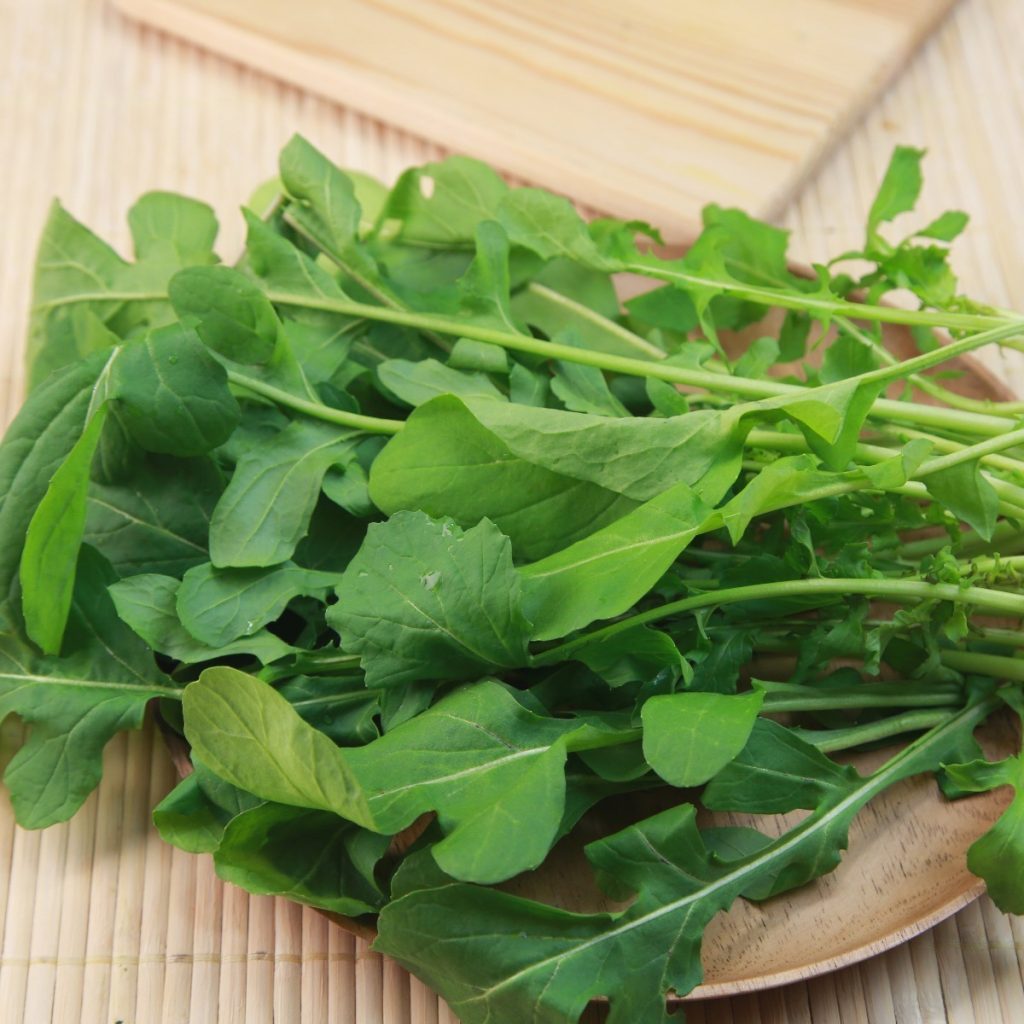
Nutrition
One of the most significant benefits of arugula is its nutritional content. It is an excellent source of vitamins A, C, and K, as well as calcium, potassium, and iron. These nutrients are essential for maintaining good health and can help prevent chronic diseases such as cancer, heart disease, and osteoporosis. Additionally, arugula is low in calories and high in fiber, making it an excellent choice for those looking to maintain a healthy weight.
Arugula is packed with antioxidants, which help protect the body from damage caused by free radicals. Free radicals are unstable molecules that can cause cellular damage, leading to inflammation and disease. Antioxidants work by neutralizing these molecules, preventing them from causing harm to the body.
Why Do Some People, Like My Dad, Call It a Weed?
Arugula is sometimes referred to as a weed because it can grow easily and quickly in specific environments, especially in areas with cool and moist climates. It is known to be a hardy plant that can thrive in a variety of soil conditions and can even tolerate some shade. As a result, it can sometimes grow spontaneously in gardens, fields, and other open areas, leading some people to view it as an unwanted weed.
While some people may view arugula as a weed, many others appreciate its unique flavor and nutritional value and actively seek it out in grocery stores and farmers’ markets. Whether you see it as a weed or a valuable food source, arugula is an exciting and versatile plant that can be a fun addition to any garden or kitchen.

What Is the Most Common Arugula Used In Salads?
The most commonly used type in salads is regular arugula. Regular arugula, also known as salad arugula, has long, green, serrated leaves and a slightly peppery taste that adds a nice flavor to salads. Its slightly bitter taste also makes it a great complement to sweeter salad ingredients, such as fruit or honey mustard dressings.
Baby arugula is another popular choice for salads, especially for those who prefer a milder and less peppery flavor. It is harvested when the leaves are still young and tender, resulting in a more delicate texture and flavor than regular arugula.
However, there are many different types of arugula, and each variety can be used in salads depending on personal preference and the other ingredients in the salad. For example, wild arugula, or sylvetta, has a slightly bitter and nutty flavor that pairs well with citrus fruits. In contrast, Italian arugula has a milder and sweeter taste that is great in salads with grilled meats or roasted vegetables.

What to Look For When Purchasing?
When buying arugula, there are a few things you should look for to ensure that you are getting the freshest and highest quality:
What to Look For | Description |
| Appearance | Bright green leaves that are crisp, not wilted. Avoid yellow or brown leaves—these indicate spoilage. |
| Smell | Fresh, peppery aroma. A strong or unpleasant odor signals the arugula is past its prime. |
| Texture | Firm and tender leaves. Avoid tough or stringy stems as they can be unpleasant to eat. |
| Packaging | Tightly sealed bag or container. Check expiration date and choose packages with the longest shelf life. |
| Organic | Choose organic when possible to avoid synthetic pesticides or fertilizers. |
| Source | Buy local or from a trusted supplier for the freshest product and best handling during transport. |
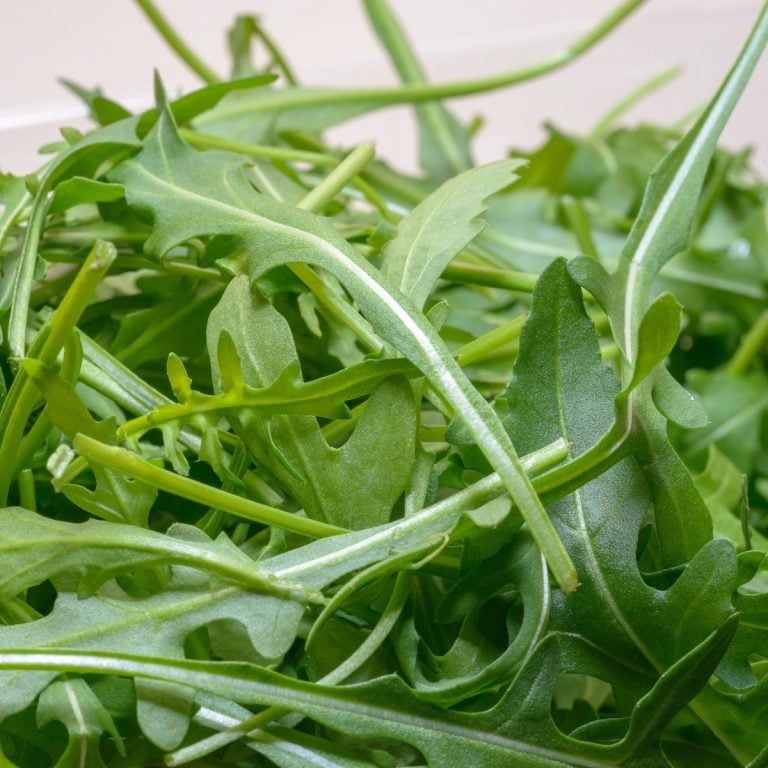
How Should You Store It?
- First, remove any rubber bands or twist ties from the arugula leaves.
- Rinse the leaves under cold running water to remove dirt or debris. Gently pat the leaves dry with a clean towel or use a salad spinner to remove excess water.
- Place the leaves in a large resealable plastic bag or an airtight container. If using a plastic bag, squeeze out as much air as possible before sealing it.
- Store it in the refrigerator in the crisper drawer, which is the coldest part of the fridge.
- If it starts to wilt or become limp, refresh it by soaking the leaves in a bowl of cold water for a few minutes, then patting them dry.
Arugula is best for the freshest flavor and texture within a few days of purchasing it. Avoid storing arugula with fruits such as apples and bananas, as these can release ethylene gas that can cause the arugula to spoil faster.
How Long Will It Last in the Refrigerator?
Arugula is a delicate leafy green that can wilt and spoil quickly, so it is essential to store it properly to maximize its shelf life. Here are some tips for storing it in the refrigerator:
- Moisture: Arugula must be stored in a cool, moist environment to prevent drying. Wrap it in a damp paper towel or place it in a plastic bag with a damp paper towel to help retain moisture.
- Airflow: it must be stored in a well-ventilated environment to prevent it from getting too damp or developing mold. Do not pack the arugula too tightly in the refrigerator; avoid storing it in a sealed container.
- Temperature: it must be stored at a cool temperature to prevent it from wilting or spoiling. Store it in the refrigerator’s crisper drawer, which is the coldest part of the fridge.
Arugula can last up to five days in the refrigerator with proper storage. However, using it as soon as possible is best to enjoy its fresh, peppery flavor and prevent it from spoiling.
What Greens Are Similar to Arugula?
If you cannot find arugula or do not like its peppery taste, there are several greens that you can use as a substitute. Here are some options:
- Watercress has a slightly peppery taste and a similar texture. It is an excellent substitute for salads or a garnish for soups and sandwiches.
- Baby spinach has a mild taste and a tender texture, making it a versatile substitute for arugula in salads and sandwiches.
- Kale has a slightly bitter taste and a sturdy texture, which makes it an excellent substitute for arugula in cooked dishes such as soups, stews, and stir-fries.
- Mustard greens have a strong, spicy flavor similar to arugula. They can be used in salads or cooked dishes such as quiches or stir-fries.
- Radicchio’s slightly bitter taste and sturdy texture make it an excellent substitute for arugula in salads. It is also commonly used in Italian cuisine.
- Endive has a slightly bitter taste and a crisp texture, making it an excellent substitute for arugula in salads. Its small, curled leaves also make it a visually appealing garnish.
Remember that each of these greens has a unique taste and texture, so the dish’s flavor may vary slightly depending on the substitute used.

Where Does Most of the Arugula in the United States Come From?
Most of the arugula consumed in the United States is grown domestically, with California being the primary source of arugula production. According to the USDA National Agricultural Statistics Service, California produces more than 90% of the country’s arugula, followed by Arizona and New Jersey.
California’s mild climate and fertile soil provide optimal growing conditions for arugula. As a result, most arugula production occurs in the state’s central and southern regions, including the Salinas and Santa Maria Valleys, where large-scale farming operations grow arugula alongside other leafy greens and vegetables.
In addition to domestic production, arugula is also imported from countries such as Italy, Spain, and France, where it is a popular ingredient in traditional cuisine. However, most arugula consumed in the US is grown locally, allowing consumers to enjoy the freshest and most flavorful.

